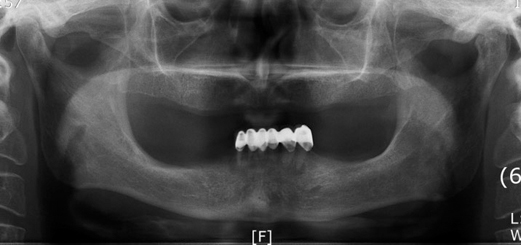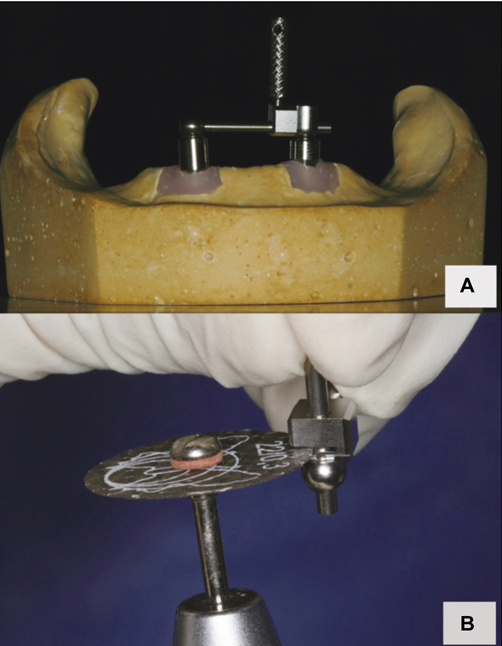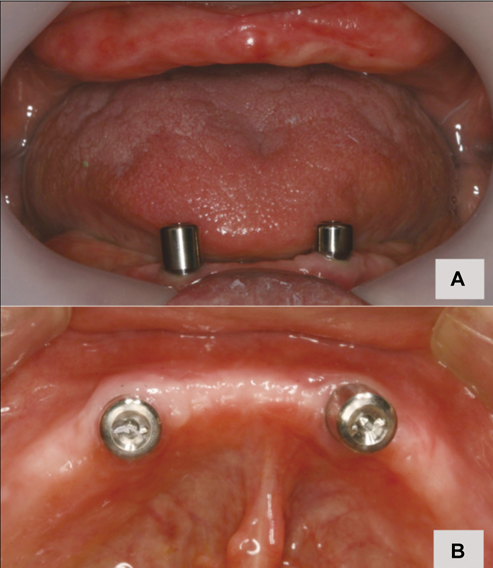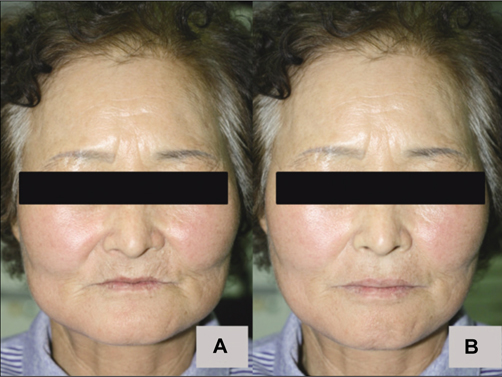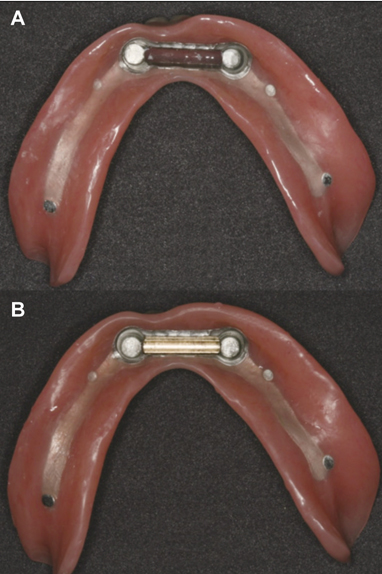J Adv Prosthodont.
2012 Nov;4(4):254-258. 10.4047/jap.2012.4.4.254.
Implant-supported overdenture with prefabricated bar attachment system in mandibular edentulous patient
- Affiliations
-
- 1Department of Dentistry, Ajou University School of Medicine, Suwon, Republic of Korea.
- 2Department of Prosthodontics and Dental Research Institute, School of Dentistry, Seoul National University, Seoul, Republic of Korea. ksh1250@snu.ac.kr
- KMID: 2176427
- DOI: http://doi.org/10.4047/jap.2012.4.4.254
Abstract
- Implant-supported overdenture is a reliable treatment option for the patients with edentulous mandible when they have difficulty in using complete dentures. Several options have been used for implant-supported overdenture attachments. Among these, bar attachment system has greater retention and better maintainability than others. SFI-Bar(R) is prefabricated and can be adjustable at chairside. Therefore, laboratory procedures such as soldering and welding are unnecessary, which leads to fewer errors and lower costs. A 67-year-old female patient presented, complaining of mobility of lower anterior teeth with old denture. She had been wearing complete denture in the maxilla and removable partial denture in the mandible with severe bone loss. After extracting the teeth, two implants were placed in front of mental foramen, and SFI-Bar(R) was connected. A tube bar was seated to two adapters through large ball joints and fixation screws, connecting each implant. The length of the tube bar was adjusted according to inter-implant distance. Then, a female part was attached to the bar beneath the new denture. This clinical report describes two-implant-supported overdenture using the SFI-Bar(R) system in a mandibular edentulous patient.
MeSH Terms
Figure
Cited by 1 articles
-
Implant-retained overdentures with pre-fabricated bar attachment system in edentulous patients
Na-Young So, Young-Gi Hong, Seung-Ryong Ha
J Korean Acad Prosthodont. 2016;54(1):41-48. doi: 10.4047/jkap.2016.54.1.41.
Reference
-
1. Bilhan H, Erdogan O, Ergin S, Celik M, Ates G, Geckili O. Complication rates and patient satisfaction with removable dentures. J Adv Prosthodont. 2012. 4:109–115.2. Takeshita S, Kanazawa M, Minakuchi S. Stress analysis of mandibular two-implant overdenture with different attachment systems. Dent Mater J. 2011. 30:928–934.3. van Kampen F, Cune M, van der Bilt A, Bosman F. Retention and postinsertion maintenance of bar-clip, ball and magnet attachments in mandibular implant overdenture treatment: an in vivo comparison after 3 months of function. Clin Oral Implants Res. 2003. 14:720–726.4. Fenlon MR, Sherriff M, Walter JD. Association between the accuracy of intermaxillary relations and complete denture usage. J Prosthet Dent. 1999. 81:520–525.5. Feine JS, Carlsson GE, Awad MA, Chehade A, Duncan WJ, Gizani S, Head T, Heydecke G, Lund JP, MacEntee M, Mericske-Stern R, Mojon P, Morais JA, Naert I, Payne AG, Penrod J, Stoker GT, Tawse-Smith A, Taylor TD, Thomason JM, Thomson WM, Wismeijer D. The McGill consensus statement on overdentures. Mandibular two-implant overdentures as first choice standard of care for edentulous patients. Gerodontology. 2002. 19:3–4.6. Vercruyssen M, Marcelis K, Coucke W, Naert I, Quirynen M. Long-term, retrospective evaluation (implant and patient-centred outcome) of the two-implants-supported overdenture in the mandible. Part 1: survival rate. Clin Oral Implants Res. 2010. 21:357–365.7. Thomason JM, Kelly SA, Bendkowski A, Ellis JS. Two implant retained overdentures-a review of the literature supporting the McGill and York consensus statements. J Dent. 2012. 40:22–34.8. Hong JW, Ahn SG, Leem DH, Seo JM. Immediate placement and functional loading of implants on canine with fixed partial denture for a patient having canine protected occlusion: a case report. J Adv Prosthodont. 2012. 4:52–56.9. Esposito M, Grusovin MG, Willings M, Coulthard P, Worthington HV. Interventions for replacing missing teeth: different times for loading dental implants. Cochrane Database Syst Rev. 2007. 04. 18. (2):CD003878.10. Esposito M, Grusovin MG, Chew YS, Coulthard P, Worthington HV. Interventions for replacing missing teeth: 1- versus 2-stage implant placement. Cochrane Database Syst Rev. 2009. 07. 08. (3):CD006698.11. Stoumpis C, Kohal RJ. To splint or not to splint oral implants in the implant-supported overdenture therapy? A systematic literature review. J Oral Rehabil. 2011. 38:857–869.12. Spazzin AO, Dos Santos MB, Sobrinho LC, Consani RL, Mesquita MF. Effects of horizontal misfit and bar framework material on the stress distribution of an overdenture-retaining bar system: a 3D finite element analysis. J Prosthodont. 2011. 20:517–522.13. Deslis A, Hasan I, Bourauel C, Bayer S, Stark H, Keilig L. Numerical investigations of the loading behaviour of a prefabricated non-rigid bar system. Ann Anat. 2012. 05. 11.
- Full Text Links
- Actions
-
Cited
- CITED
-
- Close
- Share
- Similar articles
-
- A THREE DIMENSIONAL PHOTOELASTIC STRESS ANALYSIS OF OMPLANT-SUPPORTED MANDIBULAR OVERDENTURE ACCORDING TO IMPLANT NUMBER AND ATTACHMENT TYPE
- Implant-supported milled bar overdenture with two implant surgical guides
- Effects Of Overdenture Retention On The Axial Load Of Implant In The Mandibular Implant-Supported Overdenture
- Implant-retained overdentures with pre-fabricated bar attachment system in edentulous patients
- Implant-assisted overdenture using milled bar and ADDTOC in edentulous maxilla: A case report

